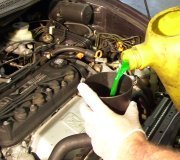Draining
Visually check engine and cooling system for signs of coolant leaks. Examine hoses for signs of cracking, distortion and security of connections. Position drain tray to collect coolant. Remove expansion tank filler cap.
Remove drain plugs from left and right sides of engine block and allow cooling system to drain. Disconnect bottom hose from radiator and allow cooling system to drain.
Disconnect top hose from thermostat and position open end of hose below level of coolant pump inlet, to allow coolant to drain from the system.
Refill
CAUTION:While flushing cooling system, DO NOT use water under high pressure as it could damage radiator.
Flush system with water under low pressure. Apply Loctite 577 to engine block drain plugs. Install drain plugs to side of engine block. Tighten to specification. See TORQUE SPECIFICATIONS.
Connect bottom hose to radiator and top hose to thermostat housing. Secure with hose clips. Prepare coolant to required concentration. Release top hose from retaining lugs on fan cowl, leaving hose to rest on lugs. Remove bleed screw from top hose. See Fig. 5.
Unclip bleed hose from battery box. Remove expansion tank from its mounting bracket. Slowly fill expansion tank with approximately 7 pints (4 liters) of coolant. Raise expansion tank approximately 8" (20 cm) vertically to allow coolant to drain into system.
Refill coolant expansion tank until a steady flow of coolant is emitted from bleed hole. Install bleed screw. With expansion tank still raised, continue filling system until coolant level reaches base of expansion tank filler neck. Install expansion tank filler cap, expansion tank to its mountings and clip bleed hose to battery box.
Install top hose into its lugs on fan cowl. Start and run engine until normal operating temperature is reached. Check for leaks. Switch off engine and allow to cool. Check for leaks and top-up coolant to cold level mark on expansion tank
Saturday, November 28th, 2009 AT 7:50 AM


